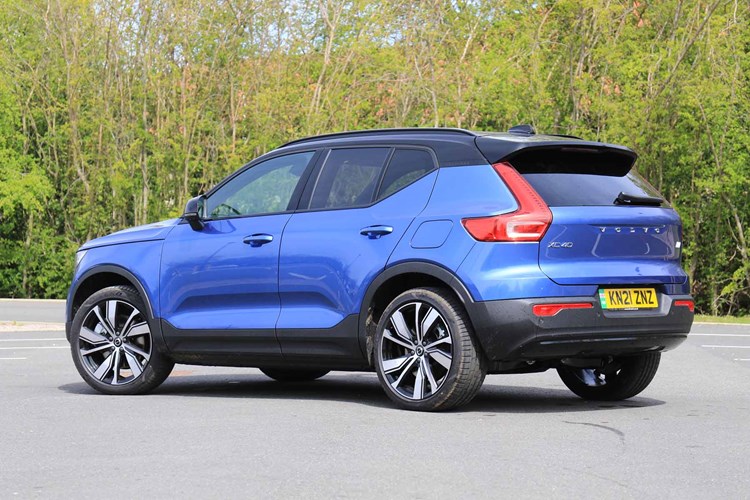Electric cars
-
The Chinese electric car seriously threatens the European competition
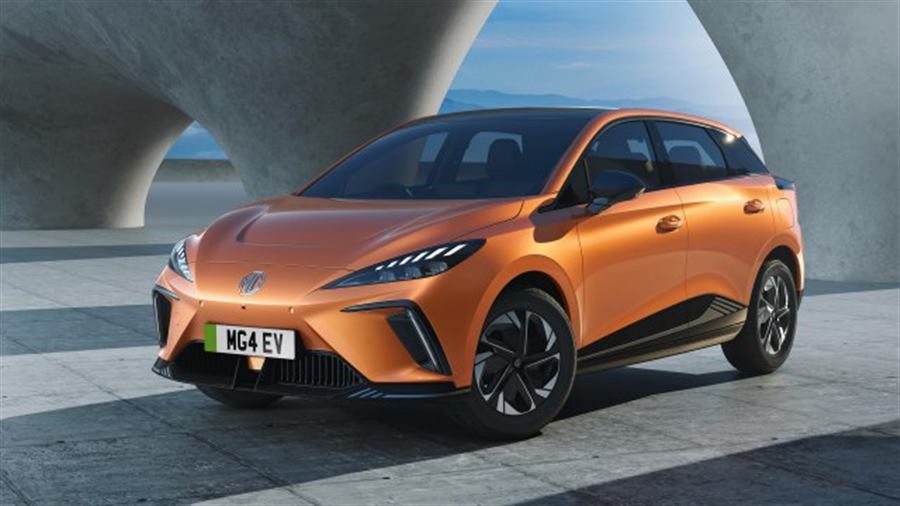
Along with the seven-year warranty, there is also an attractive starting price of 29,490 euros, which is significantly less than European rivals.
It is not necessary to write specifically about the previously defunct English brand MG, which was revived in China (owned by SAIC). Basically, this manufacturer is now back on the European continent, and has a new range of models.
One of those coming is the electric compact model MG4 Electric, which was recently introduced, and now it is known for its more than competitive price. It is the first model on the new MSP-EV modular mechanical platform that will enable the development of cars from small city models to large sedans.
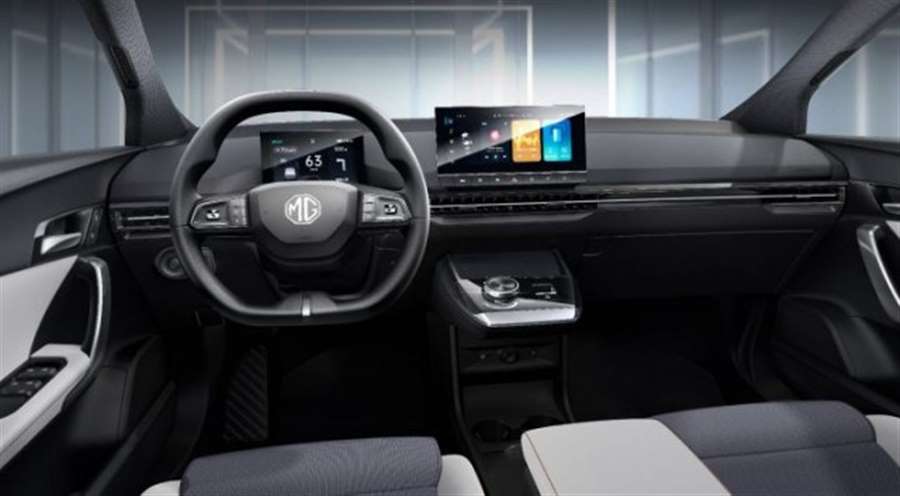
The trunk of the MG4 Electric is 363 liters. The car has two digital screens, one of seven inches behind the steering wheel and the other central, of 10.25 inches.
Between the long wheelbase and the battery (the thinnest on the market, according to MG, at just 11 centimeters thick), there's reportedly plenty of cabin space.
The MG4 Electric will be available in two variants. The first one has a battery with a capacity of 51 kWh, which enables it to have a driving autonomy of 350 kilometers.
The second, with 64 kWh, offers a range of up to 450 kilometers.
In both cases, the engine power is 150 kW (204 hp), with 250 Nm of torque. Thanks to this, the car reaches 0 to 100 km/h in less than eight seconds, even with a not so small weight of 1,655 kilograms.
With a 135 kW AC fast charge, it takes about 35 minutes to go from zero to 80% capacity.
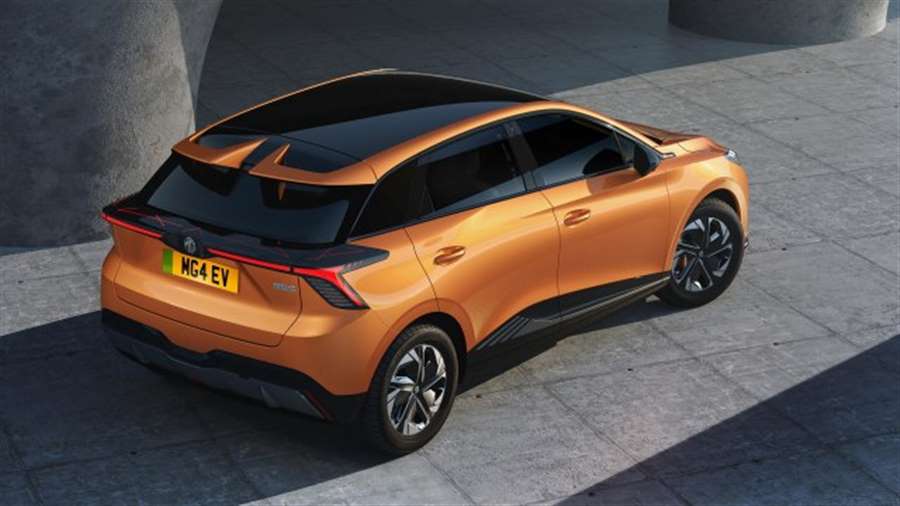
As for the brakes, they are of the "by wire" type, that is, without a physical connection between the pedal and the brake.
Starting with the basic Standard package (there are two more: Comfort and Luxury), it comes standard with features such as 360-degree cameras, voice commands, semi-autonomous driving assistant, and ultrasonic cameras and radars for active safety systems.
With a seven-year warranty, the starting price of 29,490 euros is extremely attractive, which is less than European competitors. Namely, basic models of electric compact cars start at 38 thousand euros.
-
The first solar car "for the people" will be made by the Germans, orders have exploded
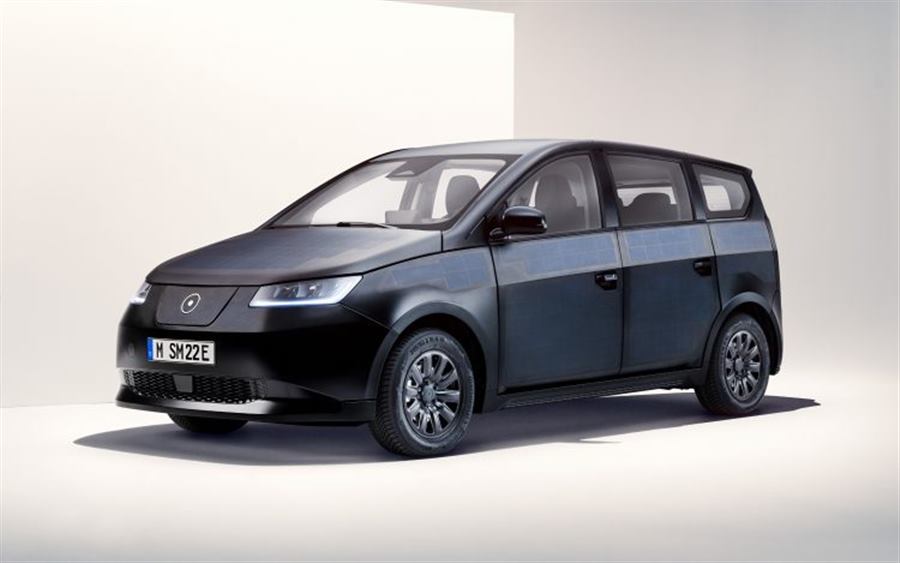
Sono Motors is a German company from Munich, and they recently announced that they will soon start production of the solar car Sion. 20,000 reservations have already arrived.
Back in 2017, the Munich manufacturer presented the Sion model, the first SEV model, that is, a solar electric car. Now this company announced that by the beginning of August this year, it had received over 20,000 reservations, each with a 2,000 euro deposit.
Sono previously announced that the Scion will have a starting price of 25,126 euros. The goal is to produce 257,000 units over seven years of production, starting in the second half of next year. Valmet Automotive from Finland will be in charge of production.
Here, the notion of a solar electric car has a completely different meaning than previous commercializations of solar panels on four wheels.
Sion has 456 cells distributed throughout the body, which ensures 112 km of range per week, but twice as much in areas with lots of sunny days. The exception is the front end, where there are no cells so that the cost of repairs in the event of a traffic accident is minimal, Index.hr writes.
In addition to the panel, Sion also has a battery with a capacity of 54 kWh, which ensures a range of up to 305 km according to WLTP. It is compatible with chargers with a power of up to 75 kW, and can also serve as an energy source with a power of up to 2.7 kW.
-
The hurricane in the USA turned electric cars into time bombs

Hurricane Ian created numerous problems in Florida, and firefighters in this American state became aware of the danger posed by submerged electric cars.
Numerous electric vehicles were under water during the hurricane, and the batteries that were soaked could soon catch fire, so the owners of such cars were warned of the danger of fire.
Jimmy Patronis, Florida's chief financial officer and state fire marshal, posted the warning on Twitter, noting that the first cases had occurred, some of which he had personally witnessed. He also posted a video of when firefighters tried to put out a fire on a Tesla Model X that caught fire in the middle of the street. One of the onlookers said that they poured more than 5,500 liters of water on the Tesla, but the car was still smoking.
Extinguishing a battery fire requires special training and understanding of electric vehicles, and a fire can last several days even with the intervention of firefighters. According to a recent study by AutoInsuranceEZ, hybrid vehicles are actually more susceptible to fires than electric vehicles, but the bigger problem is that the fire itself is extremely difficult to put out. Due to corrosion in the cells of the lithium-ion battery, the electric car can emit smoke and flames for a long time, even after being submerged in water.
As Index.hr writes, considering that Florida has the second largest number of electric vehicles in the USA (behind California), Florida is becoming aware of this problem. At the end of last year, around 100,000 electric vehicles were registered in this federal state.
-
The new king of electric cars has arrived: The first electric Rolls-Royce has three tons
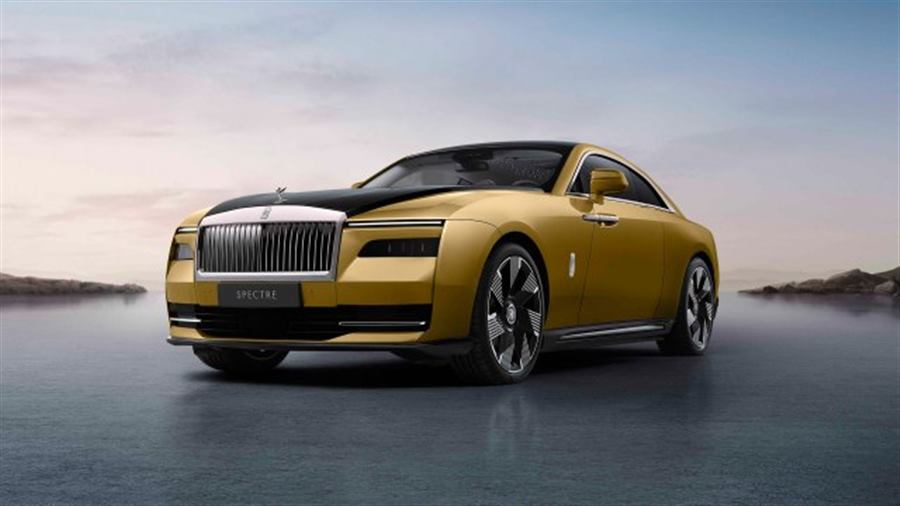
The Specter luxury coupe marked the British prestige brand's entry into the electric race.
Rolls-Royce's entry into the electric car market works in its own way. They can simply afford it, that is, they can be sure that they will easily extract a few hundred thousand euros from their fans for a huge electric coupe weighing less than three tons.
Specifically, the Specter weighs 2,975 kg, making it one of the heaviest production cars on the market right now. Of course, the Specter is not a small car, so the distance between the axles is as much as 3,210 mm.
The supporting structure is aluminum, but the burden of the huge battery cannot be hidden.
The 700 kg battery is a nice ballast in the floor of the vehicle, and with a capacity of more than 100 kWh, it enables a solid driving autonomy of 520 km, according to WLTP.
The electric drive produces 585 hp and 900 Nm, which apparently in RR they consider sufficient to satisfy the appetite of future owners, but also some basic standards of the brand.
After all, the company is no stranger to electricity because Charles Rawls was thinking about an electric car more than 120 years ago. In 1900, he bought an electric vehicle and was mesmerized by the feeling of driving without noise, vibration and stench.
{vembed Y=0CndFn82-Pg}
On paper, it reaches 100 km/h in 4.5 seconds, but that really matters less in a car of this caliber.
Yes, the Specter is fast, but it should be experienced more like a road version of a luxury yacht, just as the rear of the car suggests.
Equipped with "Magic carpet ride" chassis and Planar suspension, the Specter will ride the mountain roads between Nice and St. Tropez like on rails.
It is not surprising that it was precisely on those roads that he performed the final tests and fine-tuning of the prototype before the start of production.
No need to waste words on the design. Suffice it to say - a pure classic, but also a never-wider LED-illuminated front fascia.
And yes, the lights are double, where the daytime ones are extremely thin, and the main ones are hidden under them. It's a recipe recently introduced by BMW and it didn't go over well with critics. It will probably pass here.
-
These are the best-selling electric cars in the world
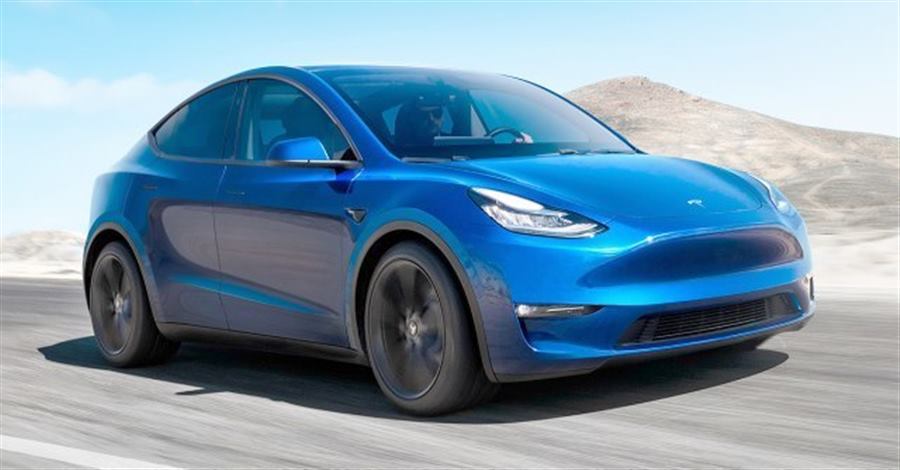
Global sales of electric cars continue to grow at record numbers.
According to EV-Volumes, 847,590 new vehicles were registered in August, which is 60 percent more than in the same period in 2021.
Globally, the market share increased to 15 percent (11 percent fully electric and four percent plug-in hybrids). By the end of August, a total of more than 5.7 million new passenger electric cars were registered, which means that even the unrealistic limit of 10 million units could be exceeded by the end of the year. For comparison, in 2021, 6.5 million of them were registered.
As for the best-selling models, the Tesla Model Y is at the top, and among the ten most popular are the Tesla Model 3, Volkswagen ID.4 and as many as seven Chinese cars, according to Jutarnji.hr.
As you will see in the table, the most represented brand is BYD, which is among the largest manufacturers of electric cars in the world. This year they entered the European market (Norway, Sweden, Denmark, the Netherlands, Belgium, Luxembourg and Germany), recently signed a contract with the German rent-a-car company Sixt on the delivery of 100,000 electric cars, and in the first half of the year they have already delivered 640,000 vehicles .
They do not hide their goal, they want to become the best-selling brand of electric cars in the world.
Top 20 electric models in 2022:
1) Tesla Model Y - 409,378
2) Wuling Hong Guang MINI EV - 278,838
3) Tesla Model 3 - 268,157
4) BYD Song - 239,739
5) BYD Qin Plus - 198,326
6) BYD Han - 148,512
7) BYD Dolphin - 102,620
8) Volkswagen ID.4 - 99,880
9) BYD Yuan Plus - 92,776
10) BYD Tang - 79,211
11) Li Xiang One - 75,397
12) Chery QQ Ice Cream - 72,094
13) Chery eQ1 - 68,153
14) GAC Aion Y - 67,793
15) Hyundai Ioniq 5 - 67,781
16) Changan Benny EV - 64,553
17) Hozon Neta V - 59,637
18) GAC Aion S - 58,471
19) Kia EV6 - 54,896
20) Ford Mustang Mach-E - 51,447
-
UK: Penalties for manufacturers who do not have enough electric models
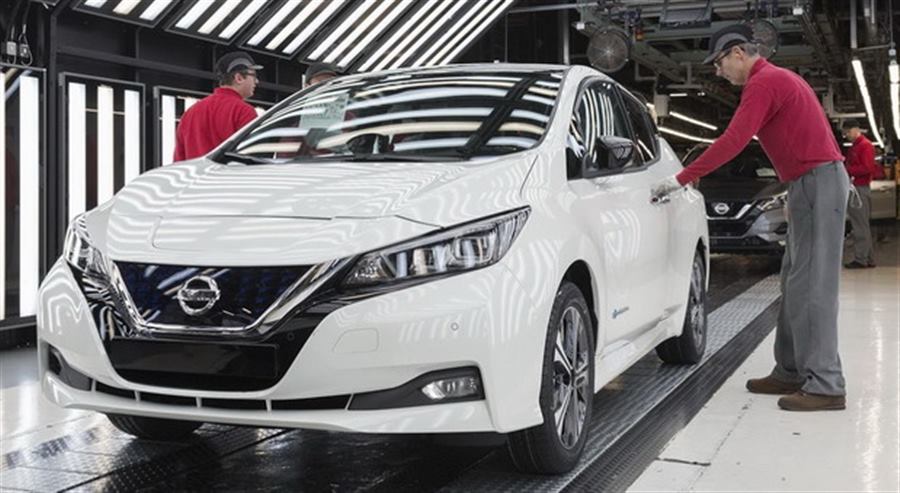
The United Kingdom will soon become the European leader in the field of reducing harmful gas emissions. As part of a revised Net Zero strategy, British government ministers have announced that they will create up to 440,000 jobs over the next ten years and free up £ 90bn for additional investment.
One of the ten key priorities is the complete electrification of the vehicle fleet, for which the Government intends to allocate around 1.62 billion pounds, and which, along with subsidies for the purchase of ecological vehicles, includes progress in the infrastructure of public charging stations, especially on local roads, Jutarnji writes. hr.
The recently presented plan to completely ban the sale of all cars that emit harmful gases by 2030, has now become even more ambitious. The ministers plan to achieve a faster transition by reducing the number of cars in cities and increasing distribution among users, generous subsidies, but also an unpopular move - penalties for car manufacturers who do not do enough to completely abolish cars powered by internal combustion engines.
Manufacturers who adhere to the new strategy will be rewarded by the Government with different types of loans, often non-repayable, and those who do not produce enough EV models - the Government will punish. The goal is to force manufacturers to sell an increasing number of zero-emission models, and the application of stricter criteria has been announced for 2024.
Critics of the new strategy point out that it is not good, because the ministers 'did it' under public pressure ahead of the Cop26 climate summit, which starts in Glasgow in two weeks. Also, the Government is criticized, which, despite great promises, in practice does not help potential buyers because it constantly reduces their benefits and subsidies.
In the UK, you can get a discount on the price of brand new low-emission vehicles through government support to agents and manufacturers who reduce the price of the vehicle by the amount of that subsidy. The maximum support for cars is £ 2,500, and to qualify for a grant, cars must cost less than £ 35,000.
The amount of support depends on the category in which the vehicle is located, and they include cars, motorcycles, mopeds, small and large vans, taxis and trucks.
-
Volkswagen announced a new electric crossover
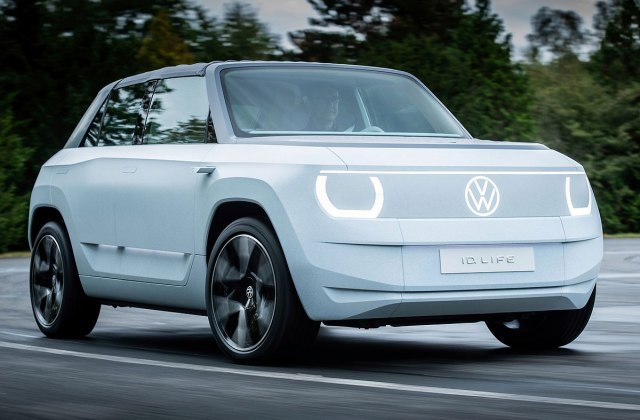
Volkswagen plans large investments in electromobility and announces a new crossover model. The German auto giant will invest 460 million euros in the modernization of the factory in Wolfsburg, which will prepare it for the production of electric models.
The production of models on the MEB mechanical platform should start already next year. This was confirmed by Thomas Schaefer, the first man of Volkswagen, who told the workers that the production of the ID.3 model will start next year, and that the factory will work at full capacity from 2024.
"Volkswagen represents electromobility for everyone. And Wolfsburg will be part of this success story," said Schaefer.
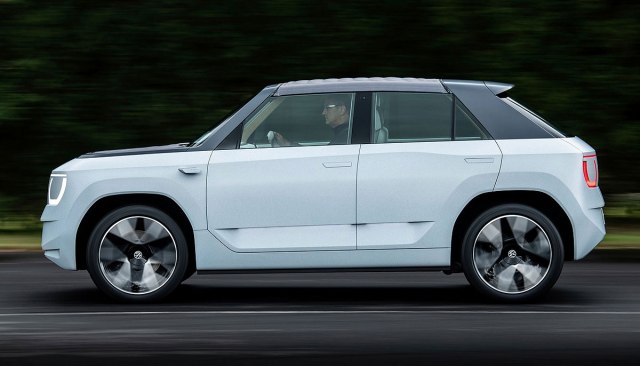
"Increasing the production capacity of the ID.3 is the first important step towards the electrification of our main plant. Along with the restyled ID.3, a new crossover is coming to the market that will use the renewed MEB platform."
The new MEB+ platform, as the biggest innovation, brings batteries with new technology, which, according to Volkswagen officials, will offer a range of up to 700 km.
Also, future models will be able to charge on 200 kW fast chargers.
"The new model will ideally complement our best-selling ID.4 and ID.5. In this way, we intend to further expand our market position and provide our customers with the high-quality vehicles they expect from us," said Šefer.
Interestingly, the MEB platform will remain in production until further notice. A total of 10 electric models have been announced until 2026, and among them is a new entry-level model with a price of 25,000 euros.
-
Volvo announced an electric SUV
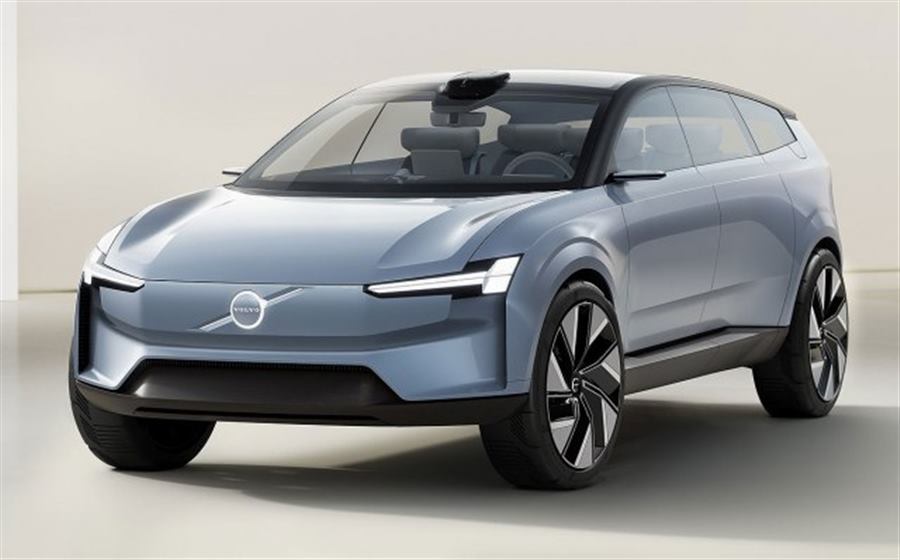
"Later this year, we will reveal our new all-electric flagship SUV," Volvo said.
Originally electric and software defined, it is a demonstration of our future and marks the beginning of a new era of security and company.
For almost 100 years, Volvo's purpose has been to innovate and set new standards to save more lives. With the latest car, the legacy continues with the introduction of new technologies that will help and accelerate progress towards the company's vision:
That no one should be seriously injured or lose their life in a new Volvo car.
"Before we show you the car later this year, Jim Rowan will present our vision for Volvo cars and safety in the future – and offer a first look at some of the new technologies that come as standard on our next all-electric SUV. It will feature innovative features designed to increase your safety as well as those around you," the announcement reads.
-
Volvo XC40 Electric review
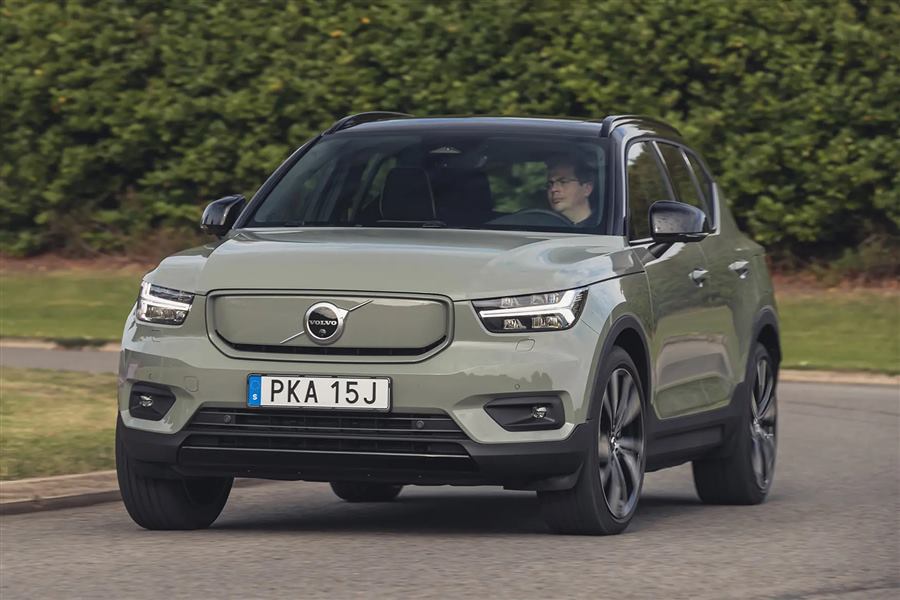
Pure-electric powertrain suits Volvo’s smallest SUV
PROS
- 408hp model has rapid acceleration
- Maximum official range of 270 miles
- Same boot and cabin space as standard car
CONS
- Expensive
- Limited info on digital gauge panel
- Not that entertaining to drive
The pure-electric Volvo XC40 Recharge bolsters the SUV’s already widely electrified model range. On top of the EV, you have a choice of mild-hybrid petrol engines and a two plug-in hybrids – but we reckon the fully electric version is the pick of the line-up.Volvo introduced the electric XC40 in 2019 and, because it was destined for launch when the car was still on the drawing board, it doesn’t make any comfort or practicality sacrifices by making the switch to battery power.
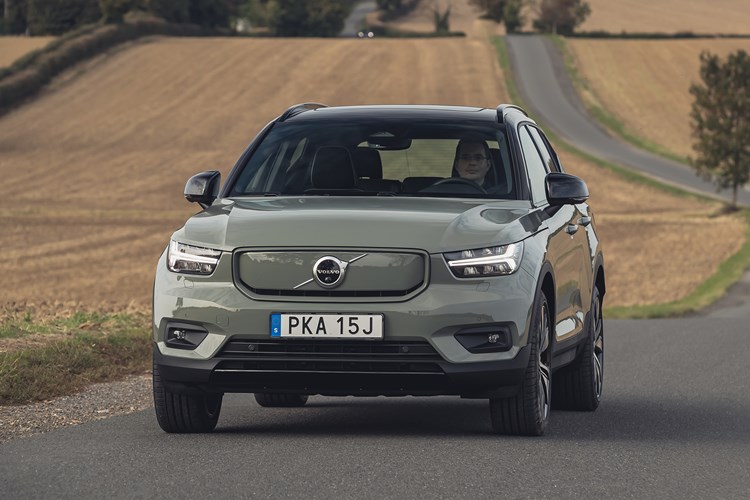 You have a choice of two electric powertrains. The entry-level front-wheel drive model has a 69kWh battery pack and a single electric motor with 231hp and 330Nm of torque. Volvo says it can sprint from 0–62mph in 7.4 seconds and that it’s capable of covering up to 264 miles on a charge.
You have a choice of two electric powertrains. The entry-level front-wheel drive model has a 69kWh battery pack and a single electric motor with 231hp and 330Nm of torque. Volvo says it can sprint from 0–62mph in 7.4 seconds and that it’s capable of covering up to 264 miles on a charge.There’s also a more expensive dual-motor, four-wheel drive option called the Recharge Twin. This model gets a larger 78kWh battery pack and an extra electric motor on the rear axle, bumping its power and torque figures up to 408hp and 660Nm respectively.
The extra grunt also slashes its 0–62mph time down to a hot hatchback-troubling 4.9 seconds, while the added battery capacity increases its maximum range to 270 miles. What’s more, both versions of the pure-electric XC40 offer support for 150kW DC rapid charging, allowing both to charge from 10–80% capacity in around half an hour.The list of rivals for the Volvo XC40 Recharge has grown since it was launched. Now, buyers can choose from the likes of the Mercedes EQA, BMW iX3, Ford Mustang Mach-E and the latest Kia Niro EV. The question is: can the aging XC40 EV still compete in this class of newcomers?
What’s it like inside?
Well-made and easy to use. You get a 12.3-inch digital gauge cluster and a 9.0-inch portrait infotainment system. Both look great and work well – their graphics are sharp, and the central screen runs on Google software which loads quickly and has built-in support for Google Maps.
The climate controls are operated through the central screen, which we’re normally not huge fans of. However, Volvo has designed a permanent toolbar for the lower edge of the display which means you don’t need to dig through a load of submenus to adjust the air conditioning.
 Volvo has also fitted the XC40 with voice control and pushed as many functions as possible through the system to minimise the amount of time you spend with your eyes off the road. You can program sat-nav instructions, change the cabin temperature and ask it to read your messages for you. It works well for the most part – but you can trip the system up if you have a regional accent.
Volvo has also fitted the XC40 with voice control and pushed as many functions as possible through the system to minimise the amount of time you spend with your eyes off the road. You can program sat-nav instructions, change the cabin temperature and ask it to read your messages for you. It works well for the most part – but you can trip the system up if you have a regional accent.Space inside is identical to the petrol-powered versions of the car. The batteries don’t eat into the boot or the cabin and the rear electric motor on the flagship Recharge Twin model occupies the same space as the petrol tank on the petrol-powered models. That means boot space is identical, at 452 litres with the rear seats in place and 1,328 litres with the bench folded flat.
Because there’s no engine up front, you also get some extra storage space under the bonnet. It only measures 31 litres, but that’s just enough space to hide the storage cables. It’s particularly useful if you’re taking the electric XC40 on a long family trip, as it means you don’t have to unpack the boot to fish the cable out from the hidden storage space under the boot board.
The build quality is impressive, too. It’s a match for any of its German rivals, with tight shut lines and soft-touch materials everywhere within your wingspan. Refinement is good, too – there isn’t much wind noise, and the sound deadening is thick enough to keep tyre roar to a minimum. That’s especially important given there’s no engine noise to drown out the road noise.
 If you want to know more about the Volvo XC40’s interior space, quality, comfort and infotainment technology, follow this link to read our main review of the car.
If you want to know more about the Volvo XC40’s interior space, quality, comfort and infotainment technology, follow this link to read our main review of the car.Comfort
The XC40’s seats are great. The front seats have loads of adjustment and clever fatigue-mitigating extras like an extendable thigh support and a thick inflatable lumbar support cushion. Both hold you in place well and stop you from slouching. The seats are well-sprung too, striking a keen balance between bracing and plushness, meaning you won’t feel tired after a long stint behind the wheel.
The rear seats are equally welcoming. They’re a good shape with plenty of padding for your lower back, which should prevent those in the rear from curling up into the shrimp position halfway through a road trip. There’s also a lot of legroom and a surprising amount of headroom – even with the panoramic sunroof fitted to the range-topping Ultimate model.
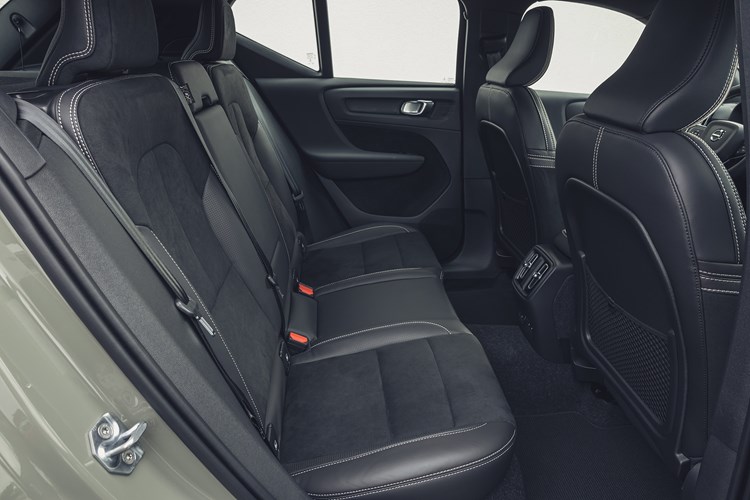 There are lots of storage bins dotted around the cabin, too, which help to keep it looking tidy even when they’re holding all the items required for family life. There’s a deep storage bin under the front central armrest, a wide wireless smartphone charging pad in the centre console and door bins that are large enough to swallow laptops, tablets and litre-sized water bottles.
There are lots of storage bins dotted around the cabin, too, which help to keep it looking tidy even when they’re holding all the items required for family life. There’s a deep storage bin under the front central armrest, a wide wireless smartphone charging pad in the centre console and door bins that are large enough to swallow laptops, tablets and litre-sized water bottles.Safety
Safety has always been Volvo’s strongest suit – and the XC40 is no exception. Euro NCAP awarded the petrol-powered version of the car a five-star rating back in 2018, and this score was also applied to the electric model in 2021. It’s worth bearing in mind that Euro NCAP has since tightened up its scoring system, but the XC40 remains a very safe way of transporting your family around.
The testers were particularly impressed with the XC40’s passenger protection ability. The car achieved a 97% score for adult occupants and an 87% score for child occupants – and the child dummies emerged from the wreckage with no major injuries.
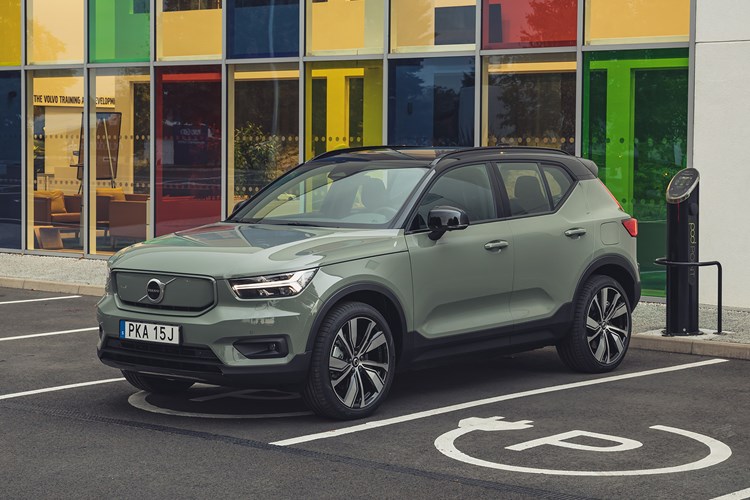 The XC40’s success can be partly attributed to its arsenal of airbags. In addition to the usual front airbags, you get a driver’s knee airbag and a full-length side curtain airbag to protect passengers’ heads, chest and pelvis. There’s also an automatic belt pretensioner which will pull occupants into their seats if the car recognises an imminent accident.
The XC40’s success can be partly attributed to its arsenal of airbags. In addition to the usual front airbags, you get a driver’s knee airbag and a full-length side curtain airbag to protect passengers’ heads, chest and pelvis. There’s also an automatic belt pretensioner which will pull occupants into their seats if the car recognises an imminent accident.We found this latter system can be a little too eager to engage. For example, if you go around a corner or over a crest a little faster than the computer would like, the seat belt will choke-slam you into the backrest. But we’d rather it errs on the side of caution than not work when you need it.
What’s it like to drive?
Agreeably pleasant, but it won’t set your trousers on fire. The range-topping 408hp Recharge Twin model is the most powerful and fastest-accelerating XC40 on sale, but it’s also the heaviest – and that makes it quite reluctant to corner with haste.
Push the car hard into a bend and Volvo’s torrent of safety features will come down on you like an anvil. The laws of physics aren’t on your side, either – the XC40 Recharge’s 2,188kg kerbweight is quite high for compact family SUV which makes the car feel a little ungainly. At least the mass is concentrated down low, which minimises the harm by dropping the car’s centre of gravity.
The front-wheel drive model is slightly nimbler as its battery is smaller and it doesn’t have the added weight of an extra electric motor over the rear axle. It still isn’t comfortable belting down a B-road at speed, though. Despite this, it’s quite refreshing to have a car that’s unashamedly geared towards comfort in a class of supposedly “sporty” rivals.
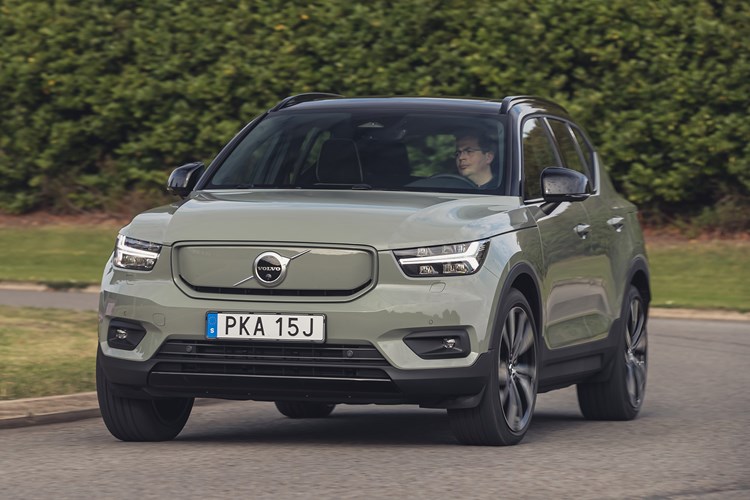
The suspension is supple and the chassis doesn’t crash over bumps, even with the car’s rather large standard 19-inch alloy wheels. Potholes are more noticeable around town, but the jolts they produce aren’t enough to knock the ride quality crown off the XC40 Recharge’s head.
And the XC40 EV is no slouch in a straight line. Both the front- and four-wheel drive powertrains deliver their torque instantly, meaning you always have the confidence for an overtake. Just be cautious about getting the hammer down if you’re travelling longer distances – the less smoothly you drive, the more time you’ll spend at charging stations.
Thankfully, Volvo has thought about that and has engineered the throttle pedal to encourage a more mellow driving style. Unlike some older electric cars, it isn’t a simple on / off switch – it’s progressive and feels much more like a petrol or diesel car in use.
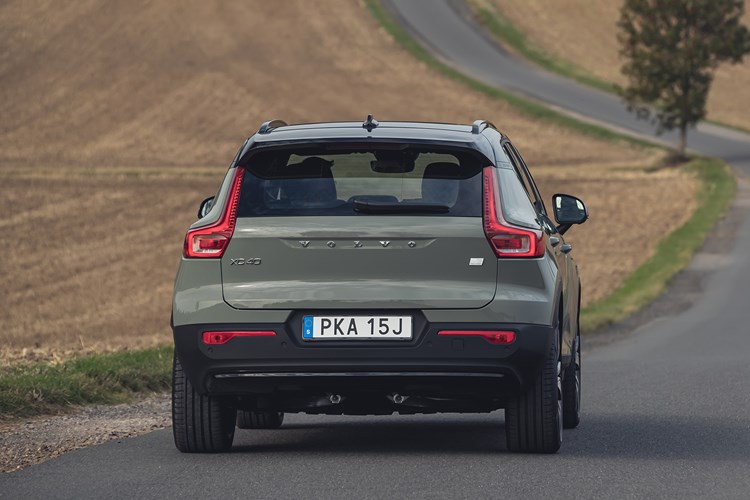 Press it gently and you get a small amount of acceleration. Batter the pedal into the floorboards and you get everything the powertrain has to offer which, in the 408hp model, gives you a very satisfying shove into your seat. Rather cleverly, though, the same action applies in reverse for the regenerative braking system. So, if you lift your foot off the throttle quickly, the brake regen is more severe than it is if you ease off the pedal gently.
Press it gently and you get a small amount of acceleration. Batter the pedal into the floorboards and you get everything the powertrain has to offer which, in the 408hp model, gives you a very satisfying shove into your seat. Rather cleverly, though, the same action applies in reverse for the regenerative braking system. So, if you lift your foot off the throttle quickly, the brake regen is more severe than it is if you ease off the pedal gently.Click through to the next page to read our verdict on the Volvo XC40, where we’ll let you know whether it’s worth your money.
Volvo XC40 Electric verdict
Should you buy a Volvo XC40 Recharge?
If you want a small premium electric SUV, the Volvo XC40 Recharge should be on your shopping list. It’s a quality product with a comfortable ride, a good range and more safety equipment than you can shake a high-visibility vest and an accident book at.
There are more exciting electric SUVs available, such as the BMW iX3. But we think the sporty SUV niche is becoming cliché, and we found it quite refreshing to drive a family crossover that was unapologetically set up for comfort.
Volvo’s electric powertrain really suits the XC40’s easy going nature. It delivers its power effortlessly and silently, it’s smooth and the arsenal of draconian safety equipment encourages you to not drive like a hooligan. The regenerative braking system has a similar effect on your driving, too, making you look further ahead to avoid touching the brakes and wasting energy.
Prices range from between £47,000 for the entry-level front-wheel drive model to more than £60,000 for the range-topping 408hp dual-motor variant. You’ll spend the same sort of money on a Mercedes EQA or an Audi Q4 e-tron, neither of which ride anywhere near as well as the Volvo. So, it’s down to your personal preferences on comfort.
It’s also worth noting that the flagship the plug-in hybrid version of the XC40 costs around £51,000 – and for just £4,000 more you could have the range-topping front-wheel drive pure-electric model. In this instance, we reckon you’re better off with the electric option.
Just to throw another spanner in the works, bear in mind that, for a similar amount of money, you could have a very well-equipped Kia EV6. Sure, it doesn’t have the same premium image as the Volvo, but it looks great, it’s better to drive and, if you pick the right battery pack and motor combination, it can comfortably drive more than 300 miles on a charge.
Source: parkers.co.uk
-
World premiere: Electric Mercedes EQE SUV
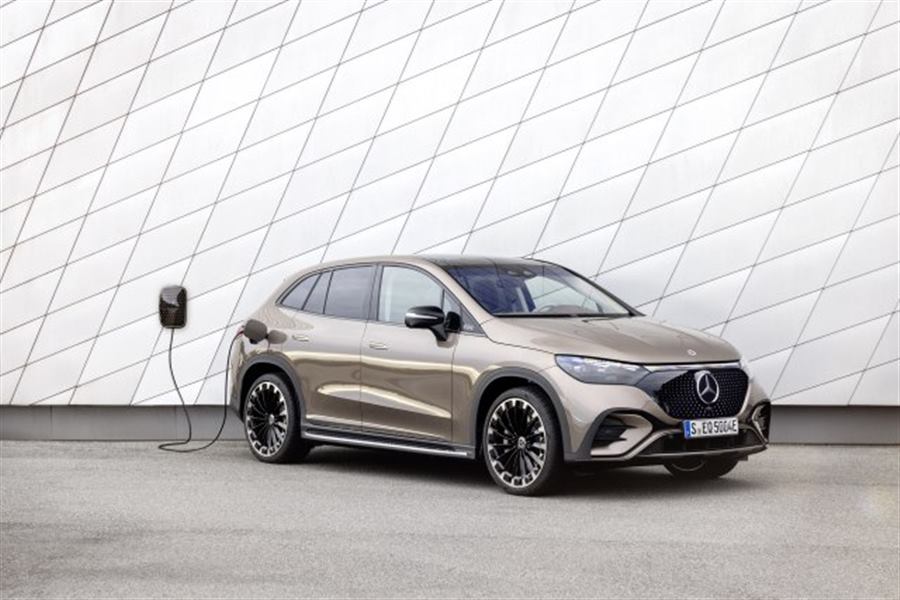
The Mercedes EQE SUV is a versatile alternative to the EQE business sedan.
Like the Mercedes EQE sedan, the new electric SUV is available with the basic innovations of the EQS model and at the same time is more dynamic than the EQS SUV model.
Mercedes says that the EQE SUV is one of the most spacious representatives of its class. Still, with a 3,030 mm wheelbase that's nine centimeters shorter than the sedan, it's more compact than the EQE sedan.
As the fourth model, following the EQS and EQE sedans, as well as the EQS SUV, the EQE SUV uses a new mechanical platform designed for three-pointed star electric vehicles.
The modular drive concept enables the EQE SUV to offer a wide range of maximum total power outputs from 215 to 300 kW. Depending on the equipment and configuration of the vehicle, the European variants of the vehicle can have a WLTP autonomy of up to 590 kilometers.
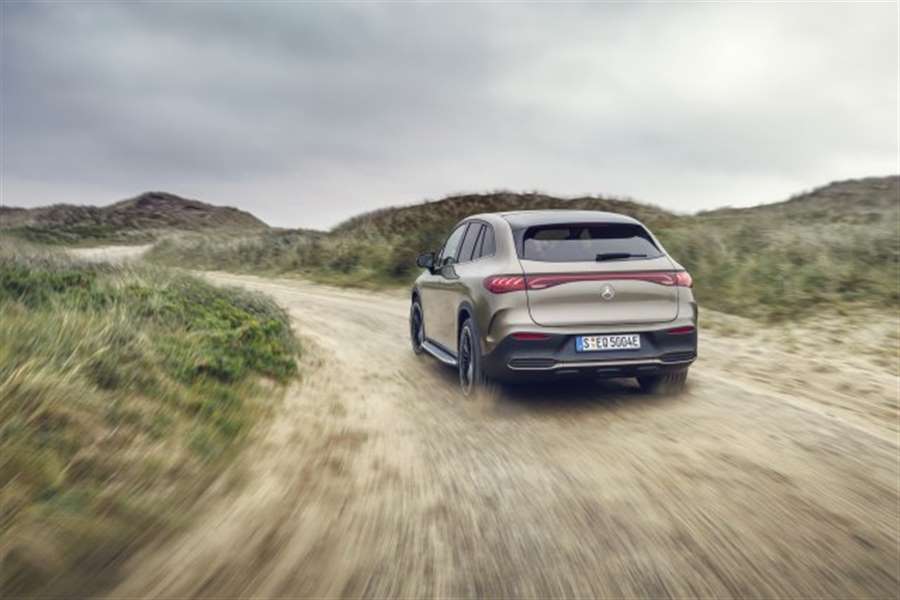
In the EQE SUV, the lithium-ion battery consists of ten modules. In certain cases, the company's innovative battery management software can be updated over-the-air (OTA).
The current generation of driving assistance systems includes a number of functions that support the driver.
General standard equipment on the EQE SUV includes ATTENTION ASSIST, Active Brake Assist, Active Lane Keeping Assist, Parking Package with reversing camera and Speed Limit Assist. System status and activity are shown full-screen on the driver assistance display.
Additional options are available in the Assistance package, as well as in the Driving Assistance Plus package.
The mechanical basis of the new EQE SUV consists of a four-link suspension at the front and a multi-link independent suspension at the rear.
Due to the relatively short wheelbase of 3,030 millimeters and the appropriate suspension settings, Mercedes claims that the car is particularly nimble and manageable even with the basic setup.
AIRMATIC air suspension with ADS+ continuously adjustable damping is available as an optional extra. To increase the ground clearance, the vehicle level can be raised by up to 30 millimeters.
In addition to the DINAMIC SELECT programs ECO, COMFORT, SPORT and INDIVIDUAL, EQE SUV models with the 4MATIC all-wheel drive system also have an OFFROAD program for off-road driving.
A rear axle steering system with a maximum steering angle of 10 degrees is available as an option.
MBUX Hyperscreen on demand
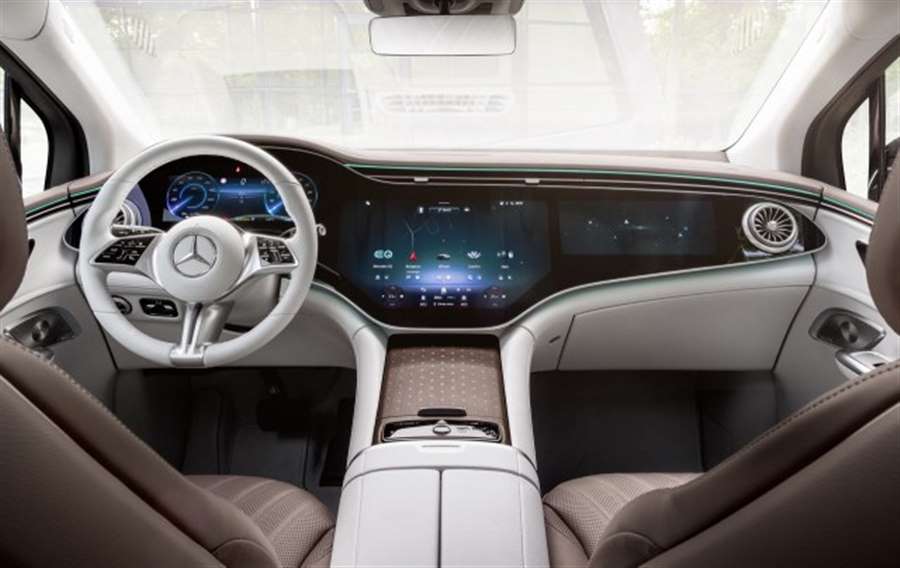
With customizable software, the MBUX display and operating system make personalized suggestions for numerous infotainment, comfort and vehicle functions. The highlight of the interior is the optional MBUX Hyperscreen.
With the MBUX Hyperscreen, the three displays merge almost seamlessly to create a screen range over 141 centimeters wide.
The front passenger in the EQE SUV has the option of a 12.3-inch OLED display with its own user interface.
The system uses intelligent camera-based blocking logic that recognizes whether the driver is looking towards the passenger display. If this is the case, the system automatically dims the dynamic content for security reasons.
Smart route planning
When it comes to navigation with "electric intelligence", the name says it all. Because based on numerous factors, it plans the fastest and most convenient route including charging stations.
It also reacts dynamically to traffic jams or a change in driving style, for example.
Navigation with electric intelligence is smart; calculates estimated charging costs per charging stop. In addition, the user can individually edit the planned routes.
Planned routes can be individually edited by adding desired charging stations along the route or excluding suggested charging stations.
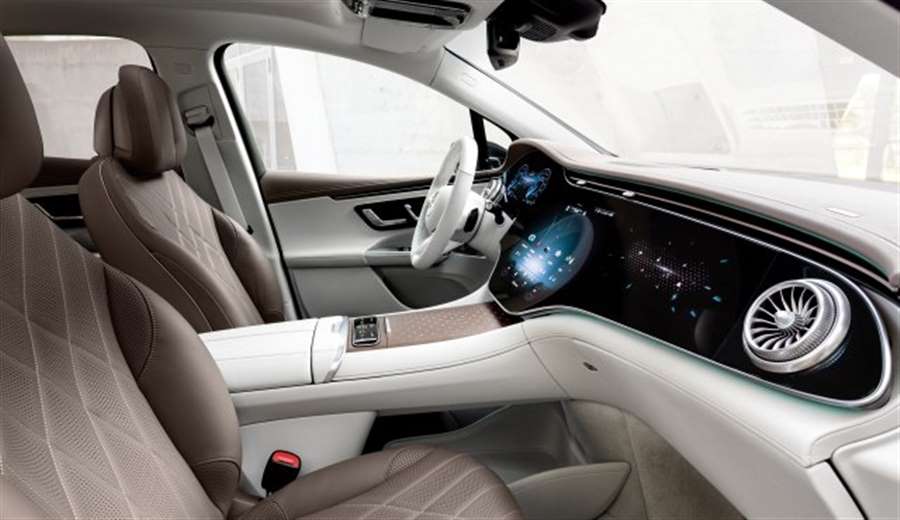
Heat pump as standard
The Mercedes EQE SUV has a sophisticated thermal architecture with a heat pump as standard. This makes the system work very efficiently: excess heat from the electric drive (inverter and electric motor) as well as high-voltage batteries that would otherwise be released into the environment can be used to heat the interior.
This drastically reduces battery consumption for the heating system, thus increasing the range.
Another useful and efficient function is air conditioning control before departure. The THERMATIC automatic climate control system with two climate zones is standard in the vehicle, while THERMOTRONIC with four zones is available as an option.
Adjusted charging tariffs
From June 2022, Mercedes me Charge offers three new charging tariffs in Europe that are tailored to individual driving performance.
"Mercedes me Charge S" for occasional charging, "Mercedes me Charge M" for normal charging and "Mercedes me Charge L" for frequent charging.
With the introduction of a new, transparent tariff system, fixed prices that are valid regardless of the operator are partially available to customers. With the Plug & Charge function, the EQE SUV can also be easily charged.
Lots of high-tech features
The DIGITAL LIGHT headlight technology (special equipment) enables innovative functions, such as the projection of auxiliary markings or warning symbols onto the road.
Another highlight of the equipment is the ENERGIZING AIR CONTROL Plus. The HEPA (High Efficiency Particulate Air) filter cleans the incoming outdoor air at a very high level of filtration. ENERGIZING COMFORT connects the various comfort systems in the vehicle.
Individual ENERGIZING COMFORT programs allow a special program for good mood depending on the mood or needs of the user. This improves physical comfort and performance while driving and during breaks.
The Dolby Atmos sound format raises the audio experience in the EQE SUV to a new level, according to Mercedes.
The proportions of the EQE SUV combine function and aesthetics with the sporty character of an SUV.
Wheels in sizes from 19 to 22 inches are mounted flush with the outer edge of the body.
The EQE SUV shares some aerodynamic measures with models from the same family. The chassis with numerous aerodynamic details plays a central role in the very good drag value Cd of 0.25, which is achieved despite the large cargo volume and short rear overhang.
But the dimensional concept with the flat windshield, broad roofline and recesses were also important factors.
High level of passive safety
The principles of Integral Safety apply regardless of the type of drive system. Like all other Mercedes Benz models, the EQE SUV therefore has a rigid passenger compartment, special deformation zones and state-of-the-art restraint systems.
The European version of the EQE SUV can detect whether the rear seats are actually occupied. If the passenger in the back is not wearing a seat belt, the driver receives a special warning. The so-called passenger presence reminder can indicate children in the back of the vehicle.
In vehicles for Europe, Australia, New Zealand, USA and Canada, this system is fitted as standard.
Motorization
Mercedes will initially offer three versions of the EQE SUV.
The basic EQE 350+ with rear-wheel drive and a single electric motor of 292 HP (215 kW) develops 565 Nm of reverse torque.
It is followed by the EQE 350 4Matic with 4-wheel drive and two electric motors. It is interesting that the total power is the same as in the rear-wheel drive model (292 hp), but the maximum torque is higher thanks to the additional electric motor and is 765 Nm.
At the top of the range is the EQE 500 4Matic, also with all-wheel drive and two electric motors. The total power of this version is 408 hp (300 kW) and the torque is 858 Nm.
CO2-neutral production as part of eco-balance
Production of the EQE SUV will begin in December at the Mercedes-Benz plant in Tuscaloosa, Alabama (USA).
A battery plant in nearby Bibb County supplies batteries for this model as well as the EQS SUV.
As of this year, all Mercedes-Benz passenger car and van plants worldwide have achieved CO2 neutral production as part of their environmental balance – including the two Mercedes plants in Alabama.

